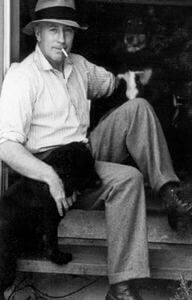Home » Creswick » History » People » The Lindsay Family » Daryl Lindsay
Daryl Lindsay
 The sixth son and ninth child of Robert and Jane Lindsay, Ernest Daryl, born on 31 December 1889, joined the Ballarat branch of the English, Scottish and Australian Bank as a junior clerk at 17. About a year later Daryl became a jackeroo. He worked for two years at Yeranbah on the Narran River, south Queensland, and took part in overlanding 9000 Shorthorns from Hebel to Camooweal. Then he put in another two years at Kulki near Argoon, before becoming an overseer first at Ercildoune, then at Trawalla near Ballarat.
The sixth son and ninth child of Robert and Jane Lindsay, Ernest Daryl, born on 31 December 1889, joined the Ballarat branch of the English, Scottish and Australian Bank as a junior clerk at 17. About a year later Daryl became a jackeroo. He worked for two years at Yeranbah on the Narran River, south Queensland, and took part in overlanding 9000 Shorthorns from Hebel to Camooweal. Then he put in another two years at Kulki near Argoon, before becoming an overseer first at Ercildoune, then at Trawalla near Ballarat.
Daryl enlisted as a driver in the Australian Army Service Corps, served in France for almost two years and became batman to his brother-in-law Will Dyson who encouraged him to make drawings of trench life and portraits of diggers. On leave in London in 1918 his talent in drawing was noticed and he was posted with the rank of honorary lieutenant to the Australian section for wounds to the face and jaw at Queen Mary's Hospital, Sidcup, Kent. Here he met Henry Tonks, head of the Slade School of Fine Art, at whose suggestion he was given one day a week to study drawing at the Slade, his task at Sidcup being to make medical diagrams for facial surgery. Tonks and Lindsay became lifelong friends and his taste in art was largely fashioned around the work of the artists of the New English Art Club, such as Walter Sickert and Wilson Steer, and patient study of the English water-colour tradition.
Back in Melbourne in June 1919 Lindsay held an exhibition of war sketches at the Decoration Art Gallery in August. He joined Dillon's Sun Art studios and designed posters for Robur tea and Swallow & Ariell puddings, and illustrations for Pals magazine. Sun Art studios published his Digger Book (1919). About 1920 he obtained a commission from the directors of the Mount Morgan Gold Mining Co. Ltd, Queensland, to make a series of drawings and water-colours of the mine. In 1921 he returned to London for further study, taking with him a letter of introduction from Sir Baldwin Spencer to Frank Rinder, adviser to the Felton bequest committee. In London Lindsay haunted the art museums and art auction houses, laying the foundation of knowledge of the art market and connoisseurship that was to serve him so well later. Rinder introduced him to men of influence in London's art world such as Harold Wright of Colnaghi's, D. W. Cameron, Sir Charles Holmes, and (Sir) George Clausen, a former Felton adviser.
In London he married Joan à Beckett, writer and daughter of Theyre à Beckett Weigall, barrister, at the Marylebone Registry Office on 14 February 1922. On returning to Melbourne they lived at St Kilda and Toorak before making a permanent home at Mulberry Hill, Baxter. Lindsay continued to work with Dillon but developed his landscape painting, sketching often in company with George Bell. In June 1924 the Fine Arts Society Gallery, Melbourne, held an exhibition of the water-colour drawings of Joan and Daryl Lindsay, and in July 1928 a second exhibition of his water-colours.
In 1930 the Lindsays returned to Europe and Daryl held an exhibition of water-colour paintings at Colnaghi's. During a visit to Ireland he painted hunters, then landscapes on the Norfolk Broads with Sir Alison Russell before returning to Australia. In June 1931 the Fine Arts Society Gallery held an exhibition of his oil paintings, and in August Art in Australia published a Daryl Lindsay number. It well reveals the style and range of interests from which his art never departed, clear and well-structured but unambitious water-colours of picturesque landscapes, and oil paintings in similar vein reminiscent of the late style of Gruner.
In the late 1930s Lindsay became a close friend of Sir Keith Murdoch and encouraged him to collect and take an active interest in art. In 1937 Lindsay and his wife again visited Europe, travelling widely on the Continent. In London he bought pictures for Murdoch, made drawings of the de Basil ballet, and was elected an associate of the Royal Society of Painters in Water Colours. In 1939, on Murdoch's advice, he applied for and was appointed keeper of the prints, National Gallery of Victoria. He was appointed director in 1941.
Under Lindsay the gallery broadened its appeal to the general public, abandoned its traditional hostility to modern art, and made notable acquisitions both of old masters and contemporary work. With Murdoch's assistance he took steps to establish the National Gallery Society of Victoria in 1947. He visited America under the auspices of the Carnegie Corporation of New York in 1952. Lindsay retired as director in December 1956 and was knighted for his services to Australian art next year. In 1960 he returned to the Northern Territory, camping with cattlemen while sketching and painting. The Legend Press later published a portfolio of reproductions of his paintings entitled 'A tribute to the men and horses of the Northern Territory'. Lindsay was a member of the Commonwealth Art Advisory Board in 1953-73 (chairman 1960-69) and founding president of the Victorian branch of the National Trust of Australia. In 1964 a book of essays was published to commemorate his services to the National Gallery of Victoria, entitled In Honour of Daryl Lindsay. He published an autobiography, The Leafy Tree, in 1965.
Survived by his wife (d.1984), Lindsay died on 25 December 1976 at Mornington and was cremated. His portrait by George Bell is at Mulberry Hill, which was left to the National Trust.

Business & Tourism Creswick Inc.
PO Box 214
Creswick, Victoria, 3363
info@creswick.net




